Disposal and Treatment
Did you know that sewage is different to sewERage?
Sewage is the wastewater, and the pipes and infrastructure that transports and treats the sewage is termed the sewerage system
What do you think happens to the water after you’ve flushed the toilet, done the dishes, or had a shower?

Historians estimate that before indoor plumbing became widespread, the average person used less than 20 liters of water per day; nowadays it is estimated that Australians and Americans use 350+ liters per day (that doesn’t include the water required to make our food as outlined in the previous module). Some of that gets used on the lawns and a bit for washing the car, but overall we use that water either for cleaning ourselves and our dishes and clothes, in which cases it ends up going down the drain, or for drinking, in which case it ends up going down the toilet. Every day each one of us turns 350+ liters of water into sewage. That's a lot of sewage, requiring a lot of treatment--and very little of it is poop!
The below diagram nicely depicts the main methods that have been developed to carry sewage (or wastewater) away from our homes and businesses. The way it works is actually quite simple and revolves mainly around pipes and gravity. Water comes into your house through pipes and leaves your house through pipes. Once you see the water go down the drain, the wastewater journey begins. Engineers aim to have the water run down hill as much as possible (otherwise they have to use expensive pumps) which is why you most always see sewage treatment plants located at low points on the landscape (e.g. near a river or by the sea). It’s a lot like a water slide at a theme park….but not one you want to catch!
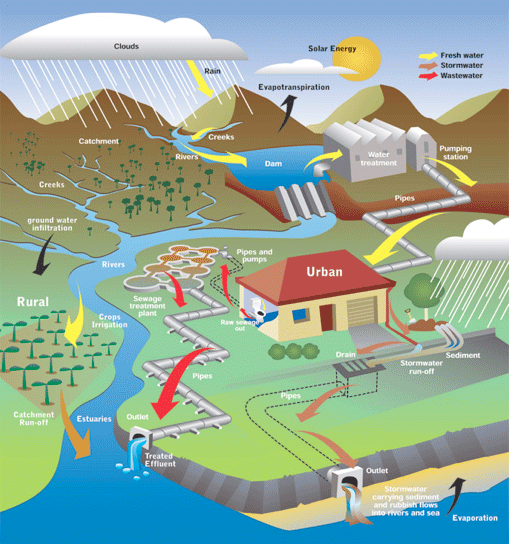 Sewage transport mechanisms
Sewage transport mechanisms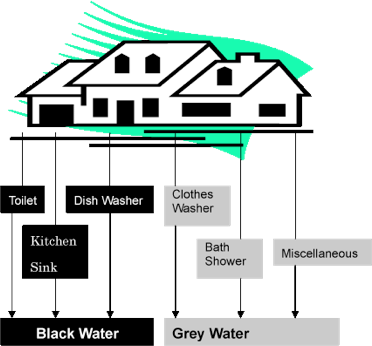
So there are a bunch of places that the water that leaves your house can go and a bunch of treatments that have been developed to try and clean it up before it is returned the natural water cycle….some work very well and others not so much. As you can expect, the cleaner we want to make the water, the more it costs….but there are advances in methods and technology that is resulting in some pretty clean water at a reasonable price.
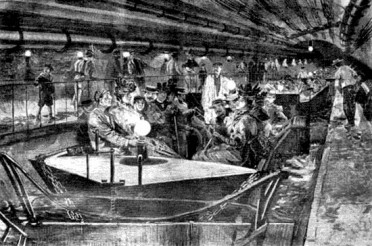 Sewer boat tours!
Sewer boat tours!As mentioned earlier, this carries our black, grey and sometimes storm water to a sewage treatment plant through a combination of gravity, pumps and most importantly moving water. Without water, the system doesn’t work. Like I said, consider it like a waterslide. No water, no slide!
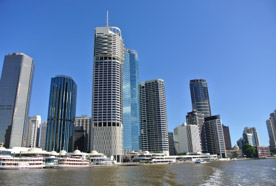
Class Discussion Point
Let's hope it is obvious why it is not safe to reuse water from the toilet. But the others aren't so clear-cut. Discuss why water from your dishwasher may not be as safe as water from your shower to use in the garden?
Not everyone’s house will be connected to a sewerage system however. Outside of big cities, houses (perhaps even your school?) are often connected to an underground septic system and are termed “decentralized”. A typical septic system consists of a septic tank and a drainfield, or soil absorption field. The septic tank is a buried, water-tight container usually made of concrete, fiberglass, or polyethylene. Its job is to hold the wastewater long enough to allow solids to settle down to the bottom (forming sludge), while the oil and grease floats to the top (as scum). Compartments and a T-shaped outlet prevent the sludge and scum from leaving the tank and traveling into the drainfield area. The liquid wastewater (effluent) then exits the tank into the drainfield. If the drainfield is overloaded with too much liquid, it will flood, causing sewage to flow to the ground surface or create backups in toilets and sinks (eek!). Finally, the wastewater percolates into the soil, naturally removing harmful coliform bacteria, viruses, and nutrients.

Although historically, stormwater was sent to the sewer (it was an easy way to get rid of the water!) many municipalities have since diverted stormwater away from the sewer. This is mainly because urban areas are growing and increasingly becoming impervious, resulting in so much water entering the sewerage system when it rains that the system couldn’t cope.
Right. Well now back to the sewer system. Has anyone ever been to a sewage treatment plant (also referred to as a wastewater treatment plant)?
What did you think, see, hear, smell, feel? Surprisingly, they are not as bad as you would think, as 95% of what ends up there is just water…..used to carry the other 5% of “stuff”. It’s this 5% that we are trying to clean up before putting all that freshwater back into the environment.
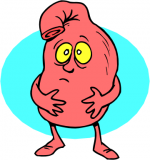
If only it was that simple however, as carbon and nutrients aren’t the only things arriving at sewage treatment plants. Here is a pretty amazing list of what else can be found in sewage:
- Pathogens such as bacteria, viruses, prions and parasitic worms
- Non-pathogenic bacteria
- Organic particles such as feces, hairs, food, vomit, paper fibers, plant material, humus, etc.
- Soluble organic material such as urea, fruit sugars, soluble proteins, drugs, pharmaceuticals, etc.
- Inorganic particles such as sand, grit, metal particles, ceramics, etc.
- Soluble inorganic material such as ammonia, road-salt, sea-salt, cyanide, hydrogen sulfide, thiocyanates, thiosulfates, etc.
- Animals such as protozoa, insects, arthropods, small fish, alligators, etc.
- Macro-solids such as sanitary napkins, nappies/diapers, condoms, needles, children's toys, dead animals or plants, iPods, etc.
- Gases such as hydrogen sulfide, carbon dioxide, methane, etc.
- Emulsions such as paints, adhesives, mayonnaise, hair colorants, emulsified oils, etc.
- Toxins such as pesticides, poisons, herbicides, etc.
- Pharmaceuticals and hormones
Phew! Imagine trying to clean all that up! Hence why it is an expensive art cleaning up sewage…..and good reason why it needs to be done!
So lets look inside a sewage treatment plant and see how it works.
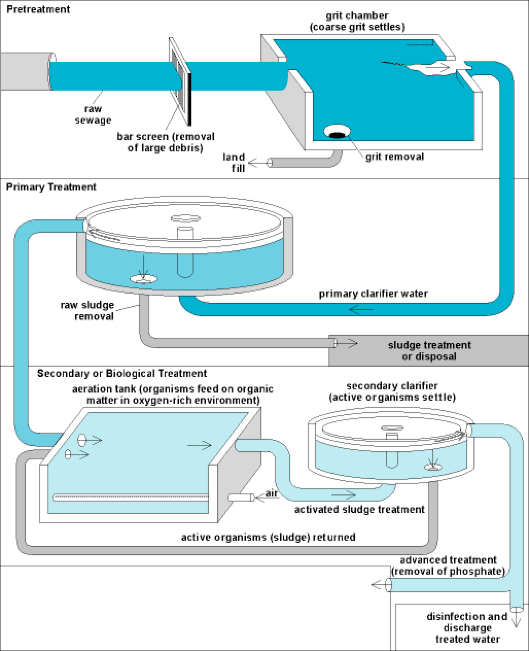
What do you think happens at each of these steps? Which steps would you consider to be physical, chemical or a biological treatment processes? Discus with your classmates and determine if your local sewage treatment plant has all these steps or more. Let us know through the comments below!
The extent of sewage treatment is generally described by the following three stages, called primary, secondary and tertiary treatment.
- Primary treatment consists of temporarily holding the sewage very still in a basin where heavy solids can settle to the bottom while oil, grease and lighter solids float to the surface. The settled and floating materials are removed and the remaining liquid may be discharged or subjected to secondary treatment.
- Secondary treatment removes dissolved and suspended biological matter. Secondary treatment is typically performed by water-borne micro-organisms in a managed habitat. Secondary treatment may require a separation process to remove the micro-organisms from the treated water prior to discharge or tertiary treatment.
- Tertiary treatment is sometimes defined as anything more than primary and secondary treatment in order to allow rejection into a highly sensitive or fragile ecosystem (e.g. estuaries, low-flow rivers, coral reefs, etc). Treated water is sometimes disinfected chemically or physically (for example, by lagoons and microfiltration) prior to discharge into a stream, river, bay, lagoon or wetland, or it can be used for the irrigation of a golf course, green way or park. If it is sufficiently clean, it can also be used for groundwater recharge or agricultural purposes. Treat it enough and you can safely drink it!
Did you know that…
New York City's 14 wastewater treatment plants together treat 5 billion liters of sewage daily?!
Once the sewage has been cleaned up to the desired level (now termed “treated effluent”), the next hurdle is doing something with all the effluent? If you can think of a way to do it, it has probably been tried. If it hasn’t been tried, you need to post it in the comments below!
The amount of effluent often dictates the most feasible approach for where it goes. If it is small amount of effluent from a remote community, it can be spread over the surface of the ground where it evaporates or soaks into the ground (called “surface disposal”) or it can be disposed of beneath the surface (subsurface disposal) such as what happens with septic systems discussed above. When you have 5 billion liters of it every day…..these options become completely unfeasible. Traditionally, with such large volumes of effluent, disposal is achieved through discharge to a river, lake, ocean, estuaries or wetlands. This results in polluting an otherwise healthy ecosystem. The degree of the effect of the pollution depends on the dilution, volume and composition of the effluent as compared to the volume and quality of the water with which it is mixed. The environmental effects of the “dilution solution” are further outlined in the next module.
Not all effluent has to be disposed of. Let’s remember that most of it is good freshwater. Treated effluent can be reused as drinking water, in industry (cooling towers), in artificial recharge of aquifers, in agriculture (70% of Israel's irrigated agriculture is based on highly purified wastewater) and in the rehabilitation of natural ecosystems (Florida's Everglades). Water reuse, wastewater reuse, and water recycling all generally mean the same thing: using treated wastewater for a beneficial purpose.

- potable reuse
- non-potable reuse
Nonpotable reuse projects treat wastewater for purposes other than drinking, such as industrial uses, agriculture, or landscape irrigation. Nonpotable reuse could also include the use of reclaimed water to create recreational lakes or to build or replenish wetlands that support wildlife. In Australia and the USA, purple pipes are used to distinguish non-potable distribution systems, helping to prevent cross-connections.
Potable reuse projects use highly treated reclaimed wastewater to augment a water supply that is used for drinking and all other purposes.
Do you know if treated effluent is used near where you live? Give some interesting examples in the comments below. You never know, someone else may just be looking for such an option where they live.

We are very lucky in Australia and the USA where regulations and funds are available to treat our wastewater before disposal or reuse. Consider this next time you causally flush the toilet or brush your teeth, you belong to only around 10% of those on the planet that have their waste treated. The remaining 90% of wastewater produced and disposed of globally is untreated, mostly in low-income countries. Think of how your local ecosystems would look, smell and feel if the waste that leaves your house/school/community was never treated.
Post Comment
To leave a comment, you must be signed in








